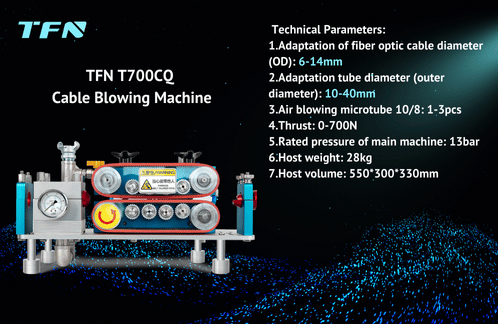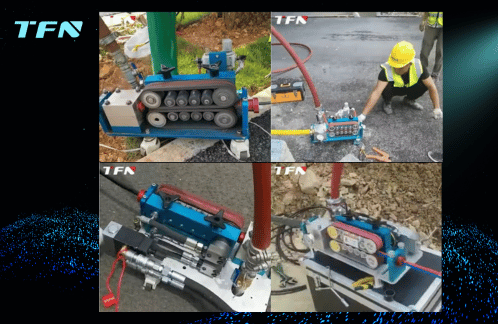TFN T700CQ Air-blown Cable Blowing Machine: Overview of Working Principle and Operation Process
Cable blowing machine is a professional equipment widely used in communication engineering. It is mainly used to push optical cables or cables forward in the laid pipeline through the power of high-pressure airflow, so as to complete the fast and lossless laying of cables. In the fields of communication Internet, highways and petroleum and petrochemical pipelines, the efficiency and safety of optical cable laying are crucial. TFN T700CQ Air-blown Cable Blowing Machine is suitable for electric and optical cables with a diameter of 6mm to 16mm, and HDPE or PE pipes with an outer diameter of 32mm to 40mm. At the same time, the equipment is an ideal choice in the above scenarios with its small size, light weight, simple operation and powerful functions. This article will analyze its working principle and operation process to help you complete the laying task.

Working Principle
The working principle of the T700CQ cable blowing machine is: the equipment is powered by the hydraulic system to drive the air compressor to generate high-pressure airflow. The mechanical cable pushing equipment sends the optical cable into the pipeline, and the high-pressure airflow is ejected through the blowing head to form a drag force, which prompts the optical cable to move quickly in the pipeline. This process combines mechanical thrust and airflow power to effectively overcome pipeline resistance and protect the outer protective layer of the optical cable.
Operation Process
1. Preliminary preparation
1.1 Equipment inspection: Ensure that the T700CQ cable blowing machine and its supporting equipment are intact, all parts are firmly connected, and there is no air leakage or oil leakage.
1.2 Accessory preparation: Check whether the high-pressure air pipe, cable plug, sealing ring, dragger, rotating body, lubricating oil and other accessories are complete and undamaged.
1.3 Personal protection: Operators should wear personal protective equipment, including safety helmets, protective glasses, protective clothing, gloves and protective shoes.
1.4 Site layout: According to the construction plan, arrange safety cones, warning signs, etc. to ensure the safety of the construction area. At the same time, place the cable blower in a suitable location and connect all necessary pipes and power supplies.
2. Start the equipment
2.1 Start the air compressor: Start the air compressor according to the instructions in the operating manual and adjust it to the appropriate air pressure value. Ensure that the air compressor runs smoothly without abnormal sounds or vibrations.
2.2 Check the status of the cable blower: Check whether the air pressure system, transmission system, control system, etc. of the cable blower are working properly. Ensure that there is enough lubricating oil in the lubricating oil cup and adjust the dripping rate.
3. Preparation and installation of optical cables
3.1 Inspection of optical cables: Check the optical cables to be laid to ensure that they are not damaged or twisted, and prepare the ends of the optical cables.
3.2 Install the dragger: Connect the optical cable to the dragger, and install the rotating body and sealing ring. Make sure that the dragger can firmly grasp the optical cable and keep it stable during the cable blowing process.
3.3 Install the cable plug: Install the cable plug at the cable outlet to prevent the optical cable from coming out of the pipeline during the cable blowing process.

4. Start cable blowing
4.1 Adjust the air pressure: Adjust the air pressure value of the air compressor to the appropriate range according to factors such as the length, diameter and curvature of the pipeline.
4.2 Start the cable blowing machine: Start the motor control switch of the cable blowing machine according to the instructions in the operating manual. At this time, compressed air will enter the pipeline through the high-pressure air pipe, pushing the dragger and the optical cable forward.
4.3 Monitor progress: During the cable blowing process, the operator should constantly monitor the progress and status of the optical cable. At the same time, keep communicating with the cable laying personnel to ensure that the cable laying speed of the optical cable matches the cable blowing speed.
4.4 Adjust the speed: In case of special circumstances such as curved or narrow pipes, the operator should promptly adjust the cable blowing speed or take other measures to ensure that the optical cable can pass safely.
5. End of work
5.1 Turn off the equipment: When the optical cable is laid to the predetermined position, turn off the cable blowing machine and air compressor in time. Cut off the power supply and air source to ensure that the equipment stops running completely.
5.2 Clean up the site: Clean up the cable blowing site and return the optical cable, cable plugs, tools and other items to their positions. At the same time, check and organize the cable blowing machine and its accessories to ensure that there are no damaged or lost parts.
5.3 Record data: Record the relevant data of this cable blowing work, including the optical cable model, length, laying time, air pressure, and special situations encountered. These data are of great reference value for subsequent construction and maintenance.
Following the above operation process, the T700CQ cable blowing machine will show excellent laying performance, reduce mechanical damage during laying, protect the outer protective layer of the optical cable, effectively improve work efficiency, and ensure the safety and health of construction personnel.
If you are interested in TFN T700CQ air-blown cable blowing machine, please contact TFN sales team:
Email: info@tfngj.com
WhatsApp: +86-18765219251
Facebook: https://www.facebook.com/tfnfate/
